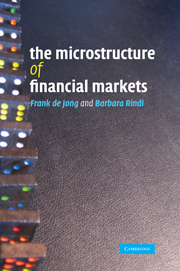Book contents
- Frontmatter
- Contents
- List of figures
- List of tables
- Preface
- Introduction
- 1 Institutions and market structure
- 2 Financial market equilibrium
- 3 Batch markets with strategic informed traders
- 4 Dealer markets: information-based models
- 5 Inventory models
- 6 Empirical models of market microstructure
- 7 Liquidity and asset pricing
- 8 Models of the limit order book
- 9 Price discovery
- 10 Policy issues in financial market structure
- Index
6 - Empirical models of market microstructure
Published online by Cambridge University Press: 05 June 2012
- Frontmatter
- Contents
- List of figures
- List of tables
- Preface
- Introduction
- 1 Institutions and market structure
- 2 Financial market equilibrium
- 3 Batch markets with strategic informed traders
- 4 Dealer markets: information-based models
- 5 Inventory models
- 6 Empirical models of market microstructure
- 7 Liquidity and asset pricing
- 8 Models of the limit order book
- 9 Price discovery
- 10 Policy issues in financial market structure
- Index
Summary
The bid–ask spread is the difference between the price at which liquidity suppliers are willing to sell (ask) and the price at which they are willing to buy (bid). In the theoretical models discussed so far, the existence of the spread is due to the adverse selection costs arising with asymmetric information and to inventory costs. This chapter concerns the basic empirical models of market microstructure, which take another component of the bid–ask spread into account, namely order processing costs. Order processing costs are the costs associated with the handling of a transaction and are typically modelled as fixed costs per share.
We emphasize that each trade has a buyer and a seller, so the costs for one party are the trading profits for another party. It is natural to look at costs from the perspective of an impatient trader, who consumes liquidity by placing market orders and pays the bid–ask spread. Adverse selection and inventory costs depend on traders' behaviour, type and preferences, and on the characteristics of the trading process. By nature, inventory costs exist only in quote-driven markets, where intermediaries have the institutional obligation to supply liquidity continuously; adverse selection and order-processing costs, on the other hand, may exist in any financial market.
In Section 6.1 we start by defining several measures of transaction costs. In Section 6.2 we define Roll's estimator, which is a particularly easy way to estimate the spread from transaction prices.
- Type
- Chapter
- Information
- The Microstructure of Financial Markets , pp. 91 - 115Publisher: Cambridge University PressPrint publication year: 2009



